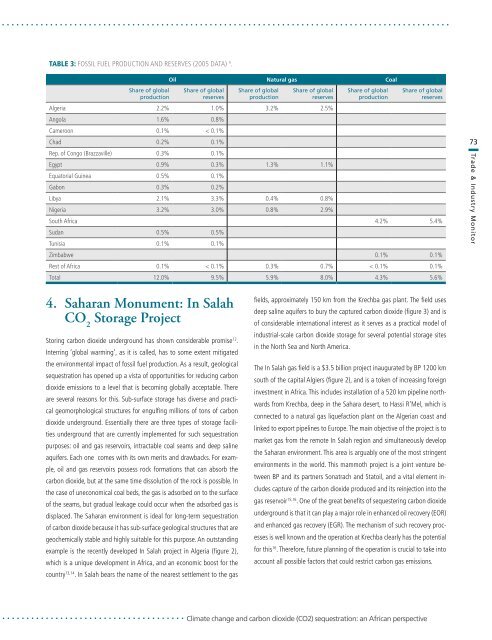Monitor Vol 39 08_Final_Nov08.pdf - tips
Monitor Vol 39 08_Final_Nov08.pdf - tips
Monitor Vol 39 08_Final_Nov08.pdf - tips
Create successful ePaper yourself
Turn your PDF publications into a flip-book with our unique Google optimized e-Paper software.
Table 3: Fossil fuel production and reserves (2005 data) 9 .<br />
Oil Natural gas Coal<br />
Share of global<br />
production<br />
Share of global<br />
reserves<br />
Share of global<br />
production<br />
Share of global<br />
reserves<br />
Algeria 2.2% 1.0% 3.2% 2.5%<br />
Angola 1.6% 0.8%<br />
Cameroon 0.1% < 0.1%<br />
Chad 0.2% 0.1%<br />
Rep. of Congo (Brazzaville) 0.3% 0.1%<br />
Egypt 0.9% 0.3% 1.3% 1.1%<br />
Equatorial Guinea 0.5% 0.1%<br />
Gabon 0.3% 0.2%<br />
Libya 2.1% 3.3% 0.4% 0.8%<br />
Nigeria 3.2% 3.0% 0.8% 2.9%<br />
Share of global<br />
production<br />
Share of global<br />
reserves<br />
South Africa 4.2% 5.4%<br />
Sudan 0.5% 0.5%<br />
Tunisia 0.1% 0.1%<br />
Zimbabwe 0.1% 0.1%<br />
Rest of Africa 0.1% < 0.1% 0.3% 0.7% < 0.1% 0.1%<br />
Total 12.0% 9.5% 5.9% 8.0% 4.3% 5.6%<br />
73<br />
Trade & Industry <strong>Monitor</strong><br />
4. Saharan Monument: In Salah<br />
CO 2<br />
Storage Project<br />
Storing carbon dioxide underground has shown considerable promise 12 .<br />
Interring ‘global warming’, as it is called, has to some extent mitigated<br />
the environmental impact of fossil fuel production. As a result, geological<br />
sequestration has opened up a vista of opportunities for reducing carbon<br />
dioxide emissions to a level that is becoming globally acceptable. There<br />
are several reasons for this. Sub-surface storage has diverse and practical<br />
geomorphological structures for engulfing millions of tons of carbon<br />
dioxide underground. Essentially there are three types of storage facilities<br />
underground that are currently implemented for such sequestration<br />
purposes: oil and gas reservoirs, intractable coal seams and deep saline<br />
aquifers. Each one comes with its own merits and drawbacks. For example,<br />
oil and gas reservoirs possess rock formations that can absorb the<br />
carbon dioxide, but at the same time dissolution of the rock is possible. In<br />
the case of uneconomical coal beds, the gas is adsorbed on to the surface<br />
of the seams, but gradual leakage could occur when the adsorbed gas is<br />
displaced. The Saharan environment is ideal for long-term sequestration<br />
of carbon dioxide because it has sub-surface geological structures that are<br />
geochemically stable and highly suitable for this purpose. An outstanding<br />
example is the recently developed In Salah project in Algeria (figure 2),<br />
which is a unique development in Africa, and an economic boost for the<br />
country 13,14 . In Salah bears the name of the nearest settlement to the gas<br />
fields, approximately 150 km from the Krechba gas plant. The field uses<br />
deep saline aquifers to bury the captured carbon dioxide (figure 3) and is<br />
of considerable international interest as it serves as a practical model of<br />
industrial-scale carbon dioxide storage for several potential storage sites<br />
in the North Sea and North America.<br />
The In Salah gas field is a $3.5 billion project inaugurated by BP 1200 km<br />
south of the capital Algiers (figure 2), and is a token of increasing foreign<br />
investment in Africa. This includes installation of a 520 km pipeline northwards<br />
from Krechba, deep in the Sahara desert, to Hassi R’Mel, which is<br />
connected to a natural gas liquefaction plant on the Algerian coast and<br />
linked to export pipelines to Europe. The main objective of the project is to<br />
market gas from the remote In Salah region and simultaneously develop<br />
the Saharan environment. This area is arguably one of the most stringent<br />
environments in the world. This mammoth project is a joint venture between<br />
BP and its partners Sonatrach and Statoil, and a vital element includes<br />
capture of the carbon dioxide produced and its reinjection into the<br />
gas reservoir 15,16 . One of the great benefits of sequestering carbon dioxide<br />
underground is that it can play a major role in enhanced oil recovery (EOR)<br />
and enhanced gas recovery (EGR). The mechanism of such recovery processes<br />
is well known and the operation at Krechba clearly has the potential<br />
for this 16 . Therefore, future planning of the operation is crucial to take into<br />
account all possible factors that could restrict carbon gas emissions.<br />
Climate change and carbon dioxide (CO2) sequestration: an African perspective
















